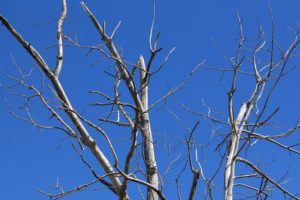
Learn how to spot whether you might have a sick or dying tree.
Due to various factors, you may find one of your trees changing in appearance due to illness. What do you do then? The first step is to call a lawn service provider like Scientific Plant Service. Early detection is one factor working to increase the likelihood of your lawn service company being able to help your tree, although sometimes a tree may be beyond help. Pay attention to the following signs to spot a sick or dying tree as soon as possible so that you can seek the appropriate services.
Leaf Damage
Discoloration, deformity, or abnormal growths on leaf tissue can all be indicators of a sick or dying tree. These symptoms range in size, shape, color, and deformity and vary depending on the tree and disease. It helps to familiarize yourself with the healthy look of your trees. If you know what your tree’s healthy leaves look like, you can more easily spot deformities and discoloration.
Canopy Decline
Generally, when a tree has lost close to 30% of its canopy, it is beyond help because your tree needs a certain amount of leaf tissue to convert sunlight into the food it needs to survive via photosynthesis. When you can see through the tree’s leaves fairly easily, that is a sign you may have a sick or dying tree. Consider taking a picture of the tree when the canopy is full for reference the following year.
Lower Shoot Growth
Diseases often start in leaf tissue and then travel to stems and branches. If you see a tree pushing leaf tissue anywhere except on the end of a branch, it often indicates a sick or dying tree under stress. This “new growth” is often triggered by the tree’s energy reserves for times when they need to convert more sunlight into energy.
Many Dead Branches
Seeing dead wood near the end of your tree’s branches is also an indicator of a sick or dying tree. You may spot a branch that looks dead at the end and is pushing new growth lower on the branch. This same tree may also have a “hole” in the canopy, where a branch or two affected by disease are not growing leaves to fill the canopy.
Early Leaf Drop or Color Changes
When the behavior associated with the change of seasons occurs earlier than usual, it is a good indicator that the tree is sick. Sometimes when the tree is diseased enough, the tree will go straight into early winter hibernation to minimize the damage. A tree changing its leaf color in July or August indicates a sick or dying tree. However, it helps to compare your tree to neighborhood trees. Are all of them changing colors? If so, the problem may not be severe. If your tree is the only one changing early, it is likely disease.
Scientific Plant Service Is Your Go-To Source In Landscape Healthcare
Scientific Plant Service, located in Baltimore, is a privately owned corporation, chartered in Maryland in 1957 by Frank J. Burke. We started as a full-service Arborists specializing in the care of shade trees and ornamental shrubs, but today we are a Lawn Care company that is a huge part of the community. From aquatic environments and snow management to deer and mole control, SPS has services tailored specifically for your lawn and landscape.
We offer services in Maryland, Washington, DC, and Virginia, including: Harford, Baltimore, Carroll, Frederick, Howard, Anne Arundel, Montgomery, Prince Georges, Talbot, Queen Anne’s, Calvert counties in MD, as well as Loudoun County, Fairfax County, Arlington, Alexandria, and Falls Church in VA. For more information, contact us online, or call us at 410-321-0970. Be sure to follow us on Facebook, Twitter, LinkedIn, and Pinterest!

